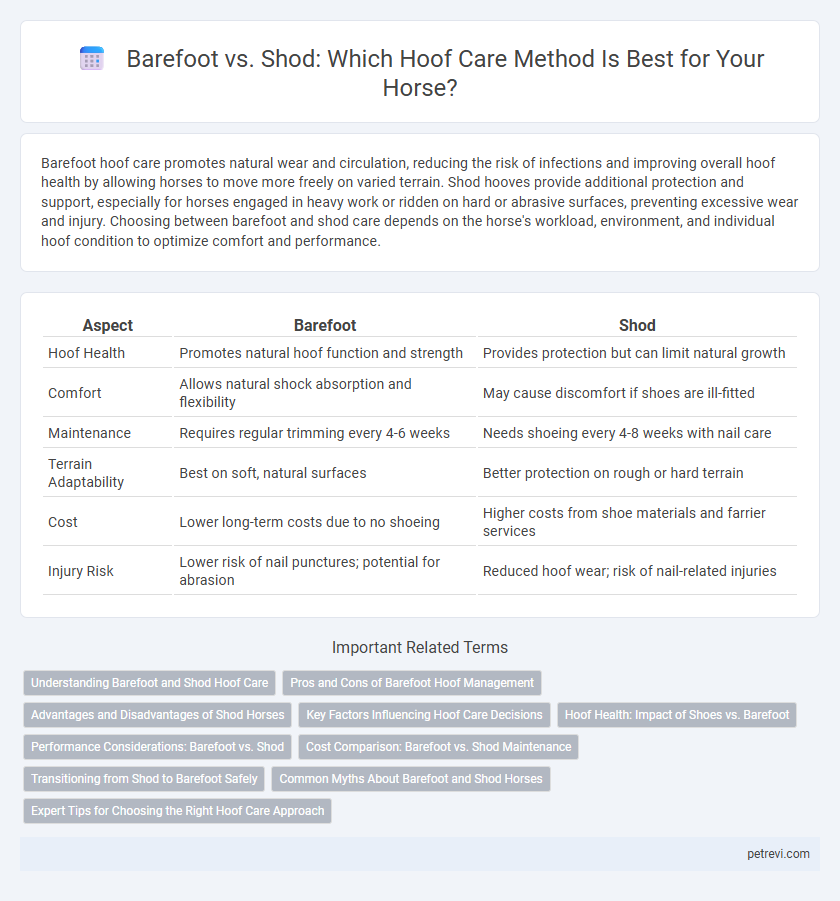Barefoot hoof care promotes natural wear and circulation, reducing the risk of infections and improving overall hoof health by allowing horses to move more freely on varied terrain. Shod hooves provide additional protection and support, especially for horses engaged in heavy work or ridden on hard or abrasive surfaces, preventing excessive wear and injury. Choosing between barefoot and shod care depends on the horse's workload, environment, and individual hoof condition to optimize comfort and performance.
Table of Comparison
| Aspect | Barefoot | Shod |
|---|---|---|
| Hoof Health | Promotes natural hoof function and strength | Provides protection but can limit natural growth |
| Comfort | Allows natural shock absorption and flexibility | May cause discomfort if shoes are ill-fitted |
| Maintenance | Requires regular trimming every 4-6 weeks | Needs shoeing every 4-8 weeks with nail care |
| Terrain Adaptability | Best on soft, natural surfaces | Better protection on rough or hard terrain |
| Cost | Lower long-term costs due to no shoeing | Higher costs from shoe materials and farrier services |
| Injury Risk | Lower risk of nail punctures; potential for abrasion | Reduced hoof wear; risk of nail-related injuries |
Understanding Barefoot and Shod Hoof Care
Barefoot hoof care emphasizes natural hoof function by allowing horses to go without shoes, promoting better circulation and reducing the risk of common shoeing injuries. Shod hoof care involves fitting horseshoes to protect hooves from excessive wear, improve traction, and assist in managing specific hoof conditions. Understanding these approaches helps optimize hoof health based on a horse's workload, terrain, and individual needs.
Pros and Cons of Barefoot Hoof Management
Barefoot hoof management promotes natural hoof function, improving circulation and reducing the risk of common issues like abscesses and thrush by allowing the hoof to expand and contract naturally. It can enhance a horse's balance and proprioception but may increase sensitivity on rough terrain, requiring gradual transition and careful monitoring. This approach often demands more frequent trims and may not suit all disciplines or individual horses with specific hoof problems.
Advantages and Disadvantages of Shod Horses
Shod horses benefit from enhanced hoof protection and traction, which is especially advantageous on hard or rocky terrain and during performance activities. However, horse shoes can restrict natural hoof expansion and contraction, potentially leading to reduced circulation and increased risk of hoof infections or damage if not properly maintained. Regular farrier visits and careful monitoring are essential to mitigate disadvantages and ensure optimal hoof health for shod horses.
Key Factors Influencing Hoof Care Decisions
Hoof care decisions between barefoot and shod approaches hinge on factors such as terrain, horse discipline, and hoof health. Barefoot care promotes natural hoof function and is often favored for horses with strong, healthy hooves in soft or varied terrains. Horses engaged in high-impact or performance activities may require shoeing to provide protection, traction, and support, especially on hard or abrasive surfaces.
Hoof Health: Impact of Shoes vs. Barefoot
Barefoot hoof care promotes natural hoof function by allowing the hoof to expand and contract, improving blood circulation and reducing the risk of common issues like thrush and white line disease. Shod horses benefit from added protection and support, especially on hard or rough terrain, but improper shoeing can lead to restricted hoof growth and increased risk of nail punctures or abscesses. Regular hoof maintenance by a qualified farrier or trimmer is essential to balance the benefits of barefoot and shod approaches while ensuring optimal hoof health.
Performance Considerations: Barefoot vs. Shod
Barefoot horses often exhibit enhanced natural traction and improved proprioception, which can lead to more efficient movement and reduced risk of slipping on varied terrains. Shod horses benefit from added hoof protection and support, allowing them to perform on abrasive surfaces and carry heavier loads without hoof damage. The choice between barefoot and shod depends on the horse's workload, terrain, and specific performance demands, with each method offering distinct advantages in durability and biomechanical function.
Cost Comparison: Barefoot vs. Shod Maintenance
Barefoot hoof care typically reduces ongoing costs by eliminating regular shoeing expenses, with maintenance focused on natural trimming every 4-6 weeks, averaging $30-$50 per session. Shod horses require shoe replacement every 6-8 weeks, costing $80-$150 per farrier visit due to materials and labor, increasing annual upkeep significantly. Long-term, barefoot maintenance can be more economical, while shod care may entail higher costs but offers protection beneficial for horses with specific hoof issues or performance demands.
Transitioning from Shod to Barefoot Safely
Transitioning from shod to barefoot requires a gradual adaptation period to strengthen the horse's hooves and prevent discomfort or injury. Regular hoof trimming by an experienced farrier and providing supportive hoof boots during the transition phase promote healthy hoof development. Monitoring moisture levels and ensuring balanced nutrition rich in biotin and zinc further enhance hoof integrity during the barefoot adjustment.
Common Myths About Barefoot and Shod Horses
Common myths about barefoot versus shod horse hoof care include the belief that barefoot horses are always healthier and freer from injury, while shod horses are perceived as weak or prone to hoof problems. In reality, barefoot hooves require careful maintenance and are not suitable for all horses, especially those regularly working on hard or rough terrain where shoes provide necessary protection and support. Scientific studies emphasize individualized hoof care, considering factors such as breed, workload, and hoof health rather than adhering strictly to barefoot or shod preferences.
Expert Tips for Choosing the Right Hoof Care Approach
Choosing the right hoof care approach depends on factors like the horse's activity level, hoof condition, and environment. Experts recommend barefoot care for horses with healthy hooves and natural terrain exposure, while shod hooves are preferable for horses engaged in intensive work or rough terrains to provide extra support and protection. Regular consultation with a skilled farrier ensures optimal hoof health and prevents common issues such as cracks, thrush, or excessive wear.
Barefoot vs Shod for Horse Hoof Care Infographic

 petrevi.com
petrevi.com